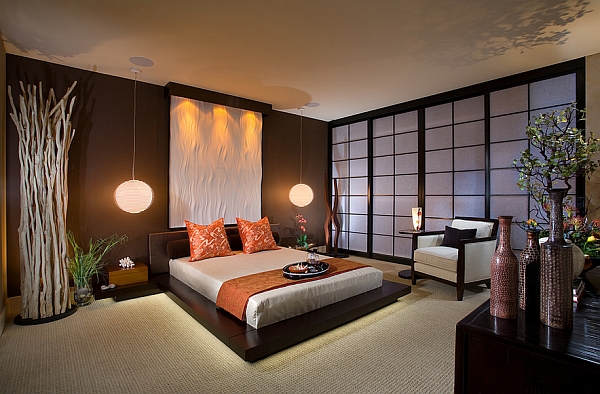[Pronounced. Fuhng-shwey] [Chinese. 風水]
[Definition. “A traditional Chinese practice, which uses energy forces to harmonise individuals with their surrounding environment”.]
We’ve all heard of the art of Feng Shui, but what does it actually mean? The philosophy dates back thousands of years, and to put it simply, Feng Shui sets out to create a balance between ourselves and our surroundings, through the arrangement of objects, use of colours, and the areas of your home that they are applied. A home with good Feng Shui will encourage a flow of nourishing energy that should allow you to feel relaxed, happy and healthy, leading to better relationships, increased productivity and having a positive effect on your personal growth. Translated literally, ‘Feng Shui’ means ‘Wind Water’ (feng = Wind, shui = water), with the philosophy teaching us that the wind carries and disperses energy, whilst the water attracts and collects it. This concept of flowing and stagnant energy can be seen throughout the basic principles of the practise, which we will explore in further detail, so you can apply Feng Sui to your home and flourish from the effects!
Qi (Chi)
Qi is a broad term used for a type of energy force, that exists around us and flows through the human body, which can affect us both physically and mentally. However, the concept of Qi is not quite as abstract as it sounds. Historically, the scientific knowledge we had of various types of energies was not known as it is today - for example, we now know that sound and light waves exist, and gravity holds us down, even if we can’t physically see or touch these things. The experiences of these energies can affect our health and wellbeing on a day-to-day basis, as they did to our predecessors, who used the term Qi to refer to them.
In principle, when Feng Shui is applied properly, it is looking to bring us comfort in our home by allowing the positive Qi to flow and blossom and stop the negative Qi collecting and decaying. For example, a plate of old food is exhibiting depleted and stagnant Qi, whilst a healthy plant is excluding vibrant and nourishing Qi. There are various methods that can be used to influence and direct the flow of Qi, such as the placements of objects, the configuration of colours and spatial design. But the main goal is to arrange your environment so that it provides you with your ideal amount of beneficial Qi, which will in turn improve your quality of life. Yin and Yang have come to symbolize the two primal forces of Qi, which is what we will explore next.
Yin & Yang
The Yin-Yang theory can be seen throughout most of the ancient Chinese schools of thought, including feng shui. According to the theory, everything in the Universe is composed of two forces – the Yin and the Yang - and the interaction between these two opposing yet complimentary forces, creates the essence of life around us. One cannot exist without the other, yet in every Yin there will be traces of Yang and vice-versa. The goal is to create a balance of the forces for optimal harmony in our homes.
Yin and Yang both represent different attributes in nature, Yin is classified as the passive, feminine energy, whilst Yang is expressed as the active, masculine energy.
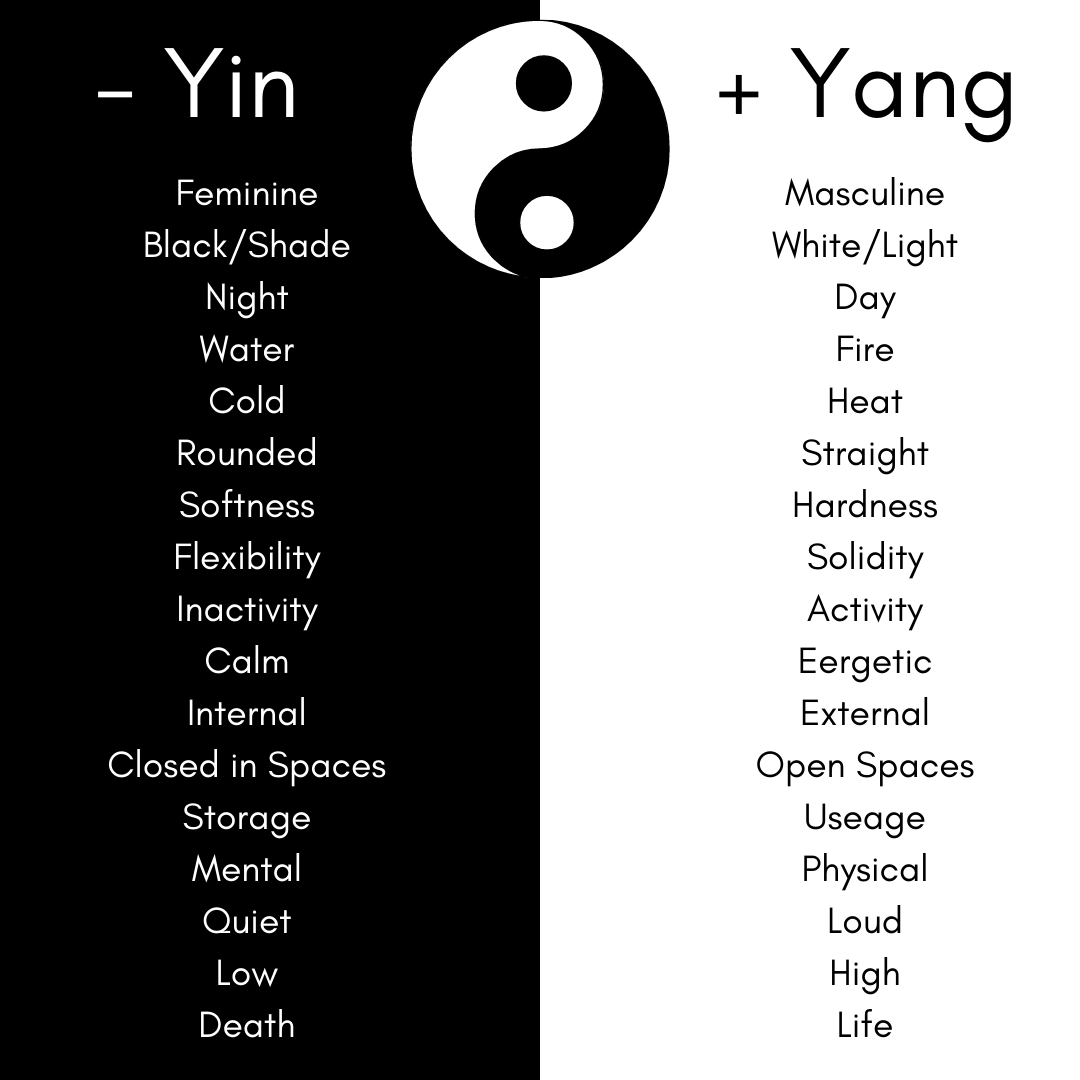
Different areas and rooms of your home serve different purposes and therefore have their own Yin and Yang requirements based on their function that should be balanced accordingly. For example, the kitchen should have a predominantly Yang energy, as this is an active area of the house, where people are usually doing something. The bedroom on the other hand, will benefit from a strong presence on Yin energy, as its important for this room to feel relaxing and quiet. Creating this balance in each room will harmonise your home and improve your wellbeing
The Five Elements
In feng shui the five elements are used to dictate the energy of a space, with each element interacting with the others, in a bid to find the perfect balance between them. The elements work in a cycle and can both strengthen or weaken one another. It is said human beings are made up of all five elements and are therefore most comfortable in an environment where all five are present. The five elements are wood, fire, earth, metal, and water.
Wood
The wood element is symbolic of growth, flexibility, creativity, and health, and is represented by green and blue tones, healthy plants, wood furniture, and vertical stripes. An abundance of the wood element will increase stubbornness, and inflexibility; whilst a scarcity of the element can cause depression, a lack of creativity and a feeling of being stuck
Fire
The fire element characterises passion, fame, inspiration, and expression. To add the fire element to your space, go for reds, pinks, and oranges, sharp or pointed items, animal prints and candles. An excess of fire can elevate strong, creative energy, but can also be dangerous, resulting in frustration, aggression, anger, and irritability. A dearth of the fire element can cause apathy, coldness, and a lack of self-esteem.
Earth
The earth element signifies balance, grounding, and stability in both your personal and professional life. To bring it into a space, use earthy tones, and introduce stones, crystals, terracotta pots and low, wide, and flat items. An extravagance of the earth element can cause boredom, and leave you feeling heavy and sluggish, whilst a shortage can make people feel chaotic, ungrounded, and unfocused.
Metal
The metal element is emblematic of logic, clarity, and productivity, and is also closely related to speech. Bring the metal element into your home by using white, grey, and metallics, anything that is metal, and round or spherical objects. An overload of metal can cause over-organisation, rigidity and being overly critical of yourself and others. A deficiency of metal can result in being excessively cautious, a lack of focus and flightiness.
Water
The water element represents prosperity, movement, purity, and the flow of emotions, and can be bought into a space by introducing dark blue, and black colours, water features, reflective surfaces, and curvy shapes. Too much of the water element can cause feelings of being overcome by unbalanced emotions, too little of the water element can leave you feeling isolated and stressed.
The relationship between the elements is a cyclical one, being both productive and destructive. The Productive cycle states that water helps wood to grow, wood in turn feeds fire. Once the fire dies down it creates earth in the form of ashes, and metal is born amongst the minerals of the Earth. Finally, metal then produces water through condensation. However, when something grows, science dictates that it must have consumed energy to do so, and therefore there is also a destructive cycle. So, water puts out fire, fire melts metal, metal cuts wood, wood exhausts the earth and earth clogs water.
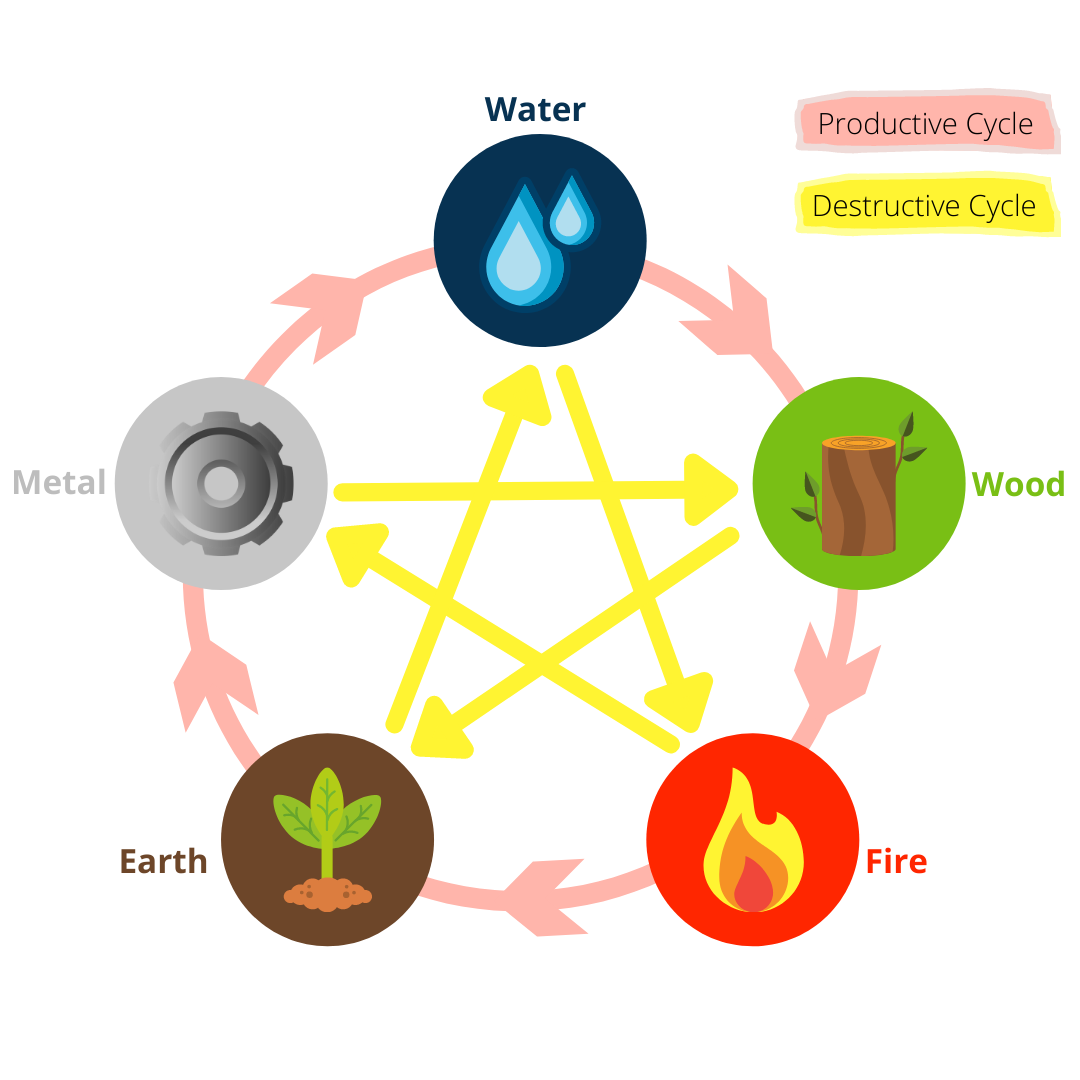
You can reduce the strength of an element by adding the element that weakens it. You can increase the power of an element by adding either more of the element itself, or the element that strengthens it. For example, if a section of your home needed more wood energy, you can either add more of the Wood element, or add more of the water element (as water strengthens wood). To decrease the wood energy in a section of your home you would either take the wood element away or add more of the metal element (as metals weakens wood). From here, you can then use the bagua map, which we will look at next to inform you what areas of your house are associated with which element and use the theory above to either boost or dampen the energy cycle.
Bagua Map
Bagua literally translated from Chinese, means ‘eight trigrams’, and it is these trigrams, or sections, centred around the middle segment, which give us the Nine life areas of the Bagua map. These sections represent important aspects of a well-balanced life, and the Bagua map is a template that can be used as guidance on which areas of the home are aligned to our lives, and which areas aren’t balanced correctly. Once we know which part of our home corresponds with which life area, we can enhance that environment using the five elements, in turn, helping us to improve that area of our life.
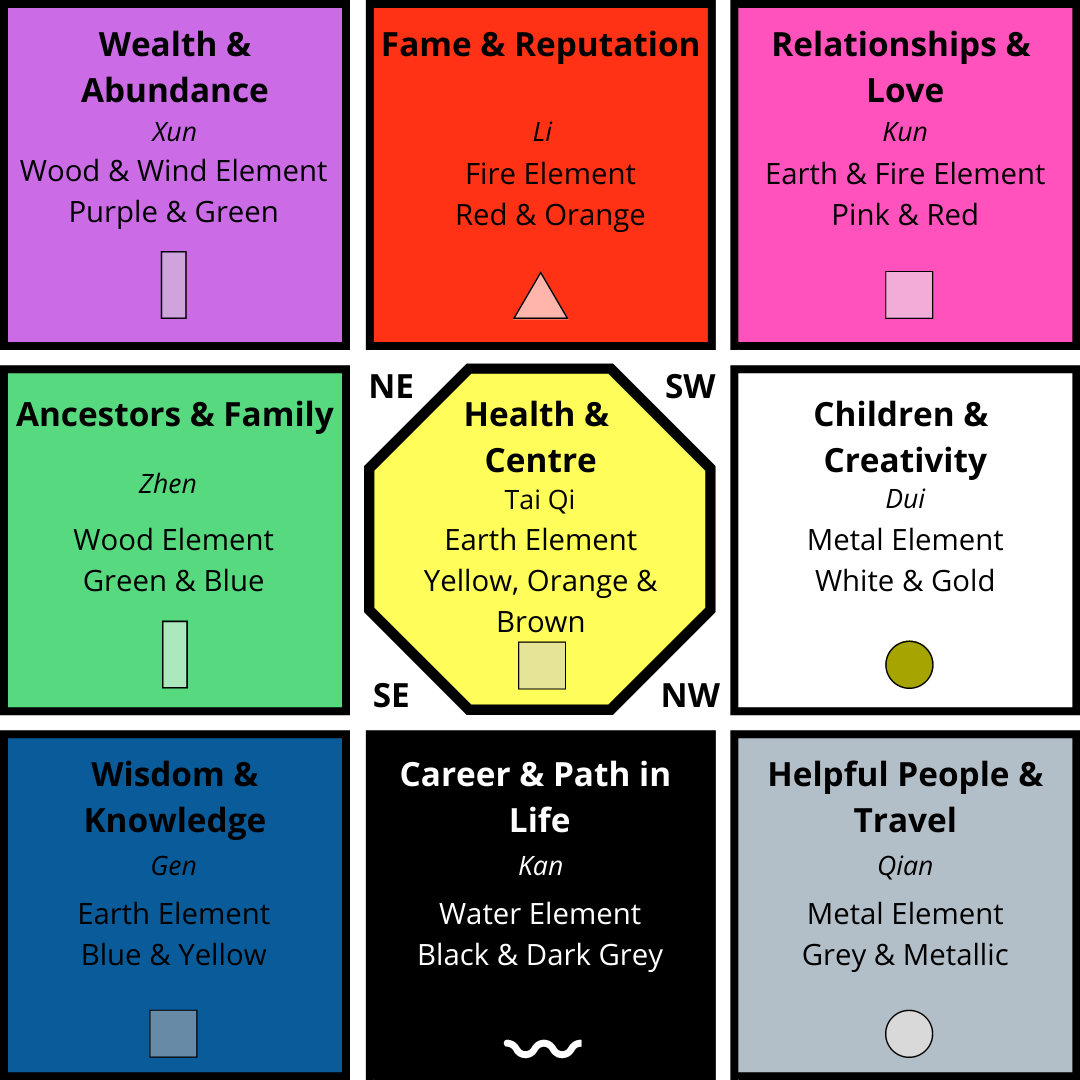
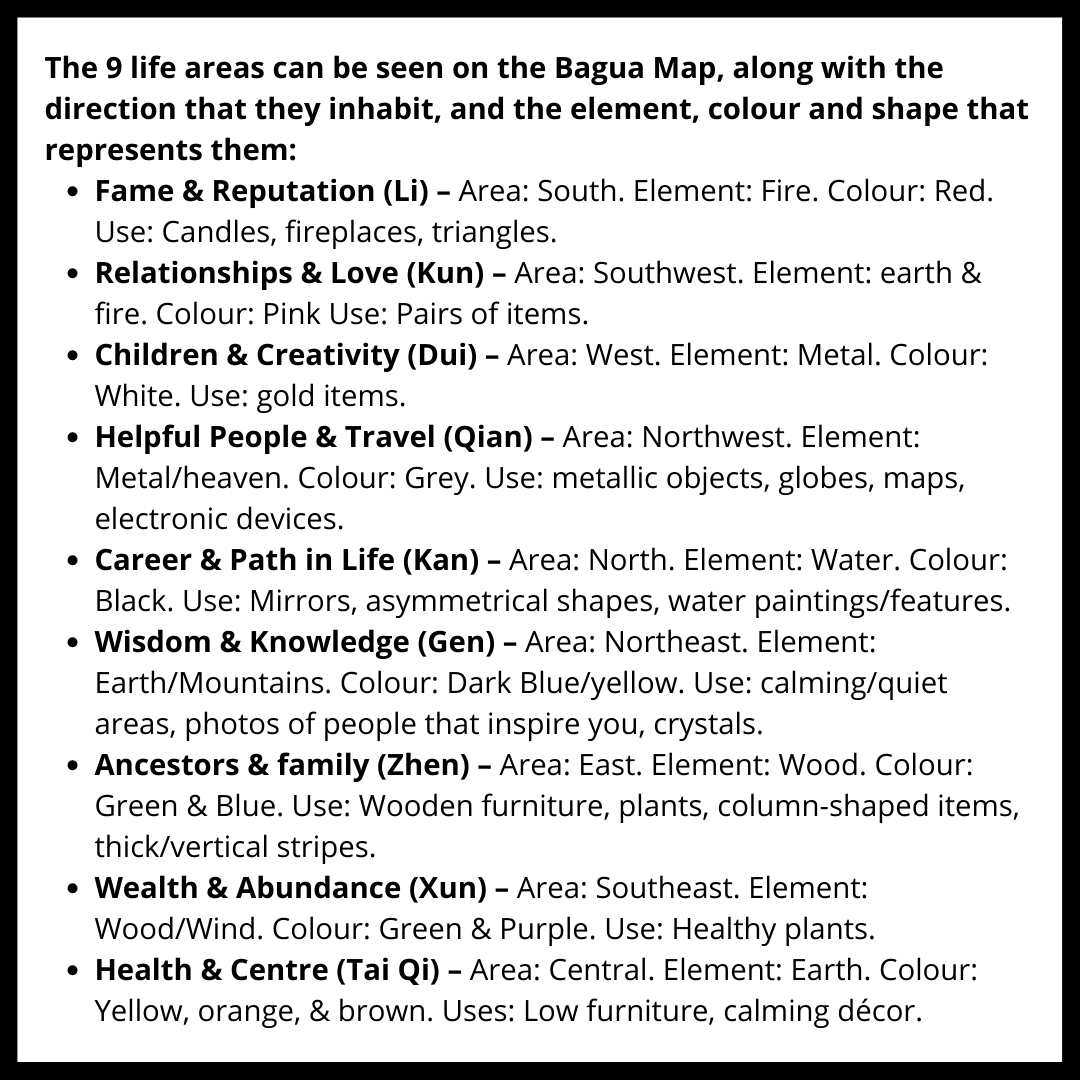
The bagua map can be applied by placing it over the floorplan of a house, room, or space (such as a desk), to reveal the areas that are lacking good Qi. This can then be remedied by adding the element that is best suited to that life area. For example, if you wanted to enhance wisdom & knowledge, you would use the bagua map to determine which area of the space is the wisdom area, and then use its corresponding element to stimulate the energy of that area. So, in this instance you would want to introduce the Earth element by adding a terracotta pot, for example. Consistent to the five-element theory, your aim is to keep the elements relatively balanced in any space, and not to overwhelm with just one element, even if it is congruent with the life area you are aiming to strengthen.
Commanding Position
Feng shui guidelines suggest that objects within a space should be laid out in a particular way to enhance our wellbeing. The commanding position within a room is the optimal position to be situated to enjoy the best flow of energy, and consequently, where you will want to spend most of your time. Therefore, it is this position where you will want to place your ‘dominant’ pieces of furniture such as your bed, desk, sofa and oven, as each of these items represent a significant aspect of your life. To find the commanding position, find the point that is furthest from, but diagonally in line with the door, so you still have a good line of sight to the entryway. The idea behind this is that you have a good view of anyone or anything that could be entering the space, so subconsciously you feel at ease, and means you are more aware of potential opportunities that may be coming your way. What further strengthens the command position is having a good solid backing behind you. For example, a good headboard behind your bed, or your desk chair backing against a solid wall will help you feel grounded and protected.
Intention Setting
Finally, the least complicated, and potentially most vital theory of them all is simply setting good intentions. In feng shui the key ingredient in whether positive qi will result in success or not is starting with the intention that it will be effective. It is believed if there is doubt in your mind, the efficacy will cease to exist. A positive frame of mind, with a healthy respect for oneself and others is the magic mantra that invites wellbeing into our homes.
On next months blog post we will be exploring how to practically implement Feng Shui into your home design, so keep a look out for that!


